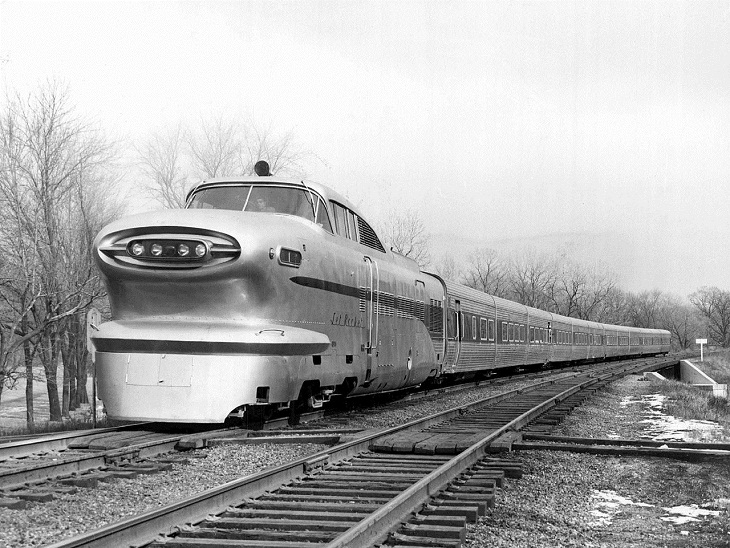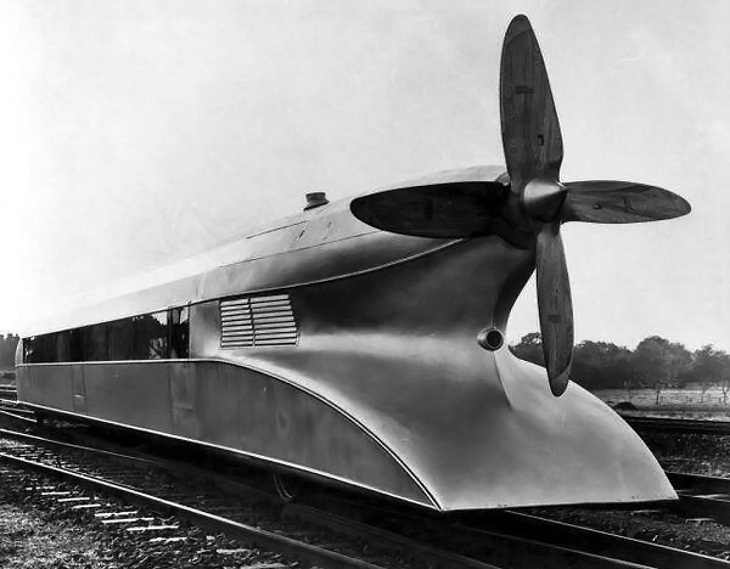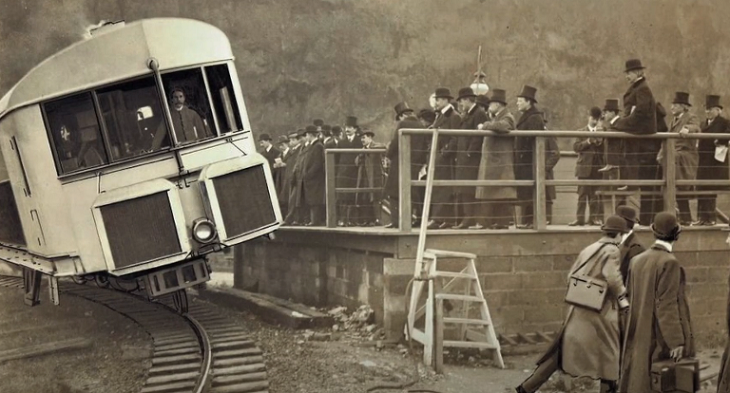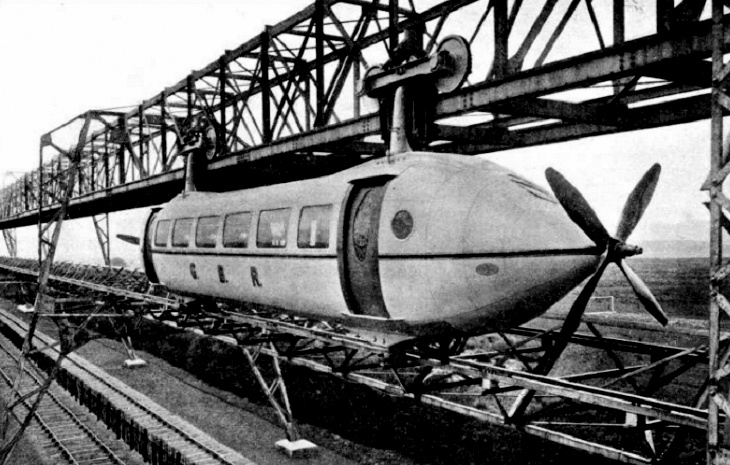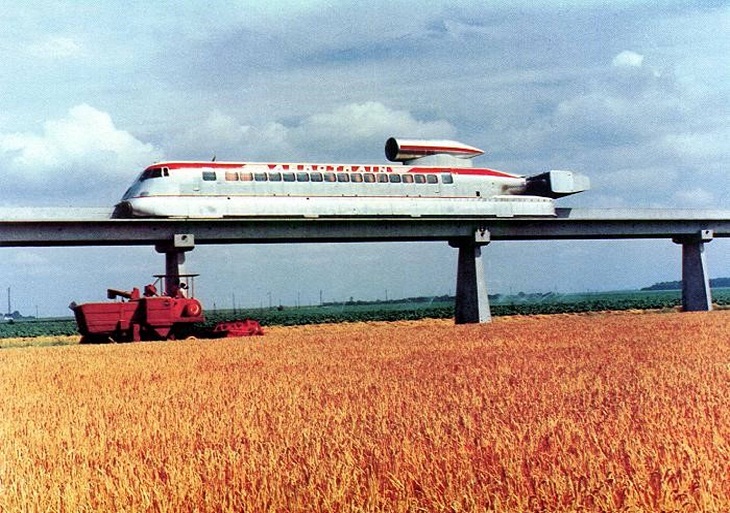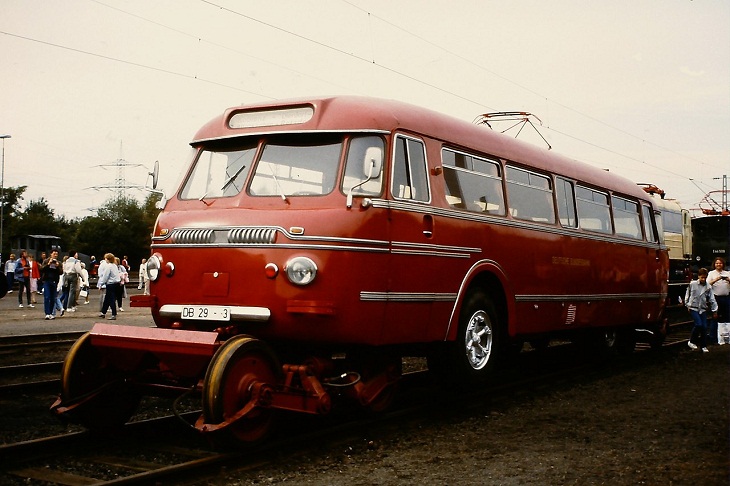The Aerotrain was an attempt by the railroad industry to compete with airplanes, but the concept did not catch on with travelers. The Aerotrain was developed by General Motors in the 1950s as an inexpensive passenger service to attract the general public back to railroads during a period of mounting losses and growing competition.
The lightweight train was designed to travel at speeds in excess of 100 mph (161 km/h) and had less than half the weight of regular steam trains when fully loaded. General Motors made two prototypes, which they gave to several railroad operators to test. Sadly, it was poorly designed, and both passengers and railroad operators disliked the prototypes. Train operators also complained that the train's engines were weak and could not reach their maximum speed or climb hills. Furthermore, passengers described riding on the lightweight train as similar to riding in a truck.
2. Schienenzeppelin
The Schienenzeppelin, or rail zeppelin, was a 1931 German attempt to build a superfast train. This experimental train was designed by engineer Franz Friedrich Kruckenberg and featured an aluminum body along with a massive propellor.
The Schienenzeppelin, which reached a record speed of 143 mph (230 km/h) in June 1931, never reached production. The reason? According to experts, its huge propellors could seriously injure or even kill those standing near the tracks at train stations. Their argument was valid because the propellors prevented the train from reversing direction, pulling other coaches, or climbing hills with momentum.
During World War II, the Schienenzeppelin was dismantled for use in aircraft manufacturing.
3. Michelin Railcar
The Michelin railcar looked like a hybrid of a passenger train and a passenger truck. Inventor André Michelin came up with this concept as a way to replace the noisy steel wheels of regular trains. His engineers designed a train that had rubber tires covering its wheels. The train was equipped with special features to prevent it from derailing if the tires burst.
The railcar, which ran on tires and was said to be very quiet, was not adopted by any of the rail companies because the prototypes were too expensive. A regular train, for instance, had only four wheels, but the Michelin railcar was equipped with ten; the extra six wheels were purely load carriers. Furthermore, they tended to wear out quickly and needed to be replaced frequently.
4. Brennan Monorail
The Brennan Gyro-Monorail was developed by Australian inventor Louis Brennan in the early 20th century. Powered by electricity, this monorail featured a single set of wheels and ran on a single track.
The train was stabilized by two linked gyroscopes, which prevented it from tipping over. Brennan's daughter agreed to assist him in conducting testing and demonstrations as part of establishing the vehicle's stability.
Brennan hoped that his invention would replace regular trains. Unfortunately, the Brennan Gyro-Monorail didn’t find any takers, despite being advocated by Winston Churchill himself. There were fears that it would only take a momentary failure of one gyro system to cause a massive derailment. Moreover, the train was not cost-effective because each vehicle in the train would need its own gyro-balancing system, complete with a power supply, to pull wagons or coaches in the usual way.
5. Bennie Railplane
Invented by engineer George Bennie in 1930, the Bennie Railplane was a revolutionary vehicle. The entrepreneur wanted to build a train that would run along a single suspended rail and not on the ground. This meant that it would not be slowed down by other vehicles on the ground.
The Railplane was equipped with two propellors on each side, while two bogies (frameworks attached to the top rail with wheels) enabled it to glide along its overhead tracks. A series of electric motors provided power.
Bennie, the son of an engineer, had a passion for trains and dreamed that his revolutionary invention would change the world. He claimed that his Railplane could reach speeds of up to 120 mph (190 km/h). However, the test track proved too small to handle such speeds. The plush interior of its 24-seat passenger area featured comfy seats and chairs, carpets, and curtained windows. Moreover, since the Railplane would be built over existing train lines, no extra land would be needed, making it an affordable option.
There were also plans to extend Railplane to London and Paris. Unfortunately, Bennie couldn’t find investors for his game-changing rail system. By 1937, Bennie, who had spent all of his own money promoting the Railplane, had fallen into bankruptcy. The train was eventually sold for scrap in 1956. Bennie passed away the following year.
6. M-497 'Black Beetle'
NYC's experimental M-497 turbojet train, also known as the "Black Beetle," was designed to attract people back to the rails who had abandoned the railroad's slower trains for other means of transportation. The concept for this train was developed in 1965 by James Wright, head of the NYC Railroad's Technical Research Center, who proposed using a jet engine to propel trains at significantly faster speeds. In essence, the Black Beetle was a regular passenger train modified to run on jet engines from a B-36 bomber.
Following a series of tests, the train reached 185 mph (295 km/h), a record that remained unbroken for 40 years.
However, jet-powered trains were too expensive to build and maintain, so the NYC Railroad soon had to cease production of the Black Beetle. The carriage was scrapped in the early 1980s after serving as a source of used parts for many years. As for its jet engines, they did prove useful and were used to make the world's first snowplow for railroad tracks.
7. Jean Bertin's Aero Carriage
The Aérotrain was a hovertrain developed in France from 1965 to 1977. Designed by French scientist and engineer Jean Bertin, this Aérotrain was a jet-driven passenger vehicle that glided along rails on a cushion of air generated by its own engine. Essentially, the new vehicle was intended to replace conventional trains and was meant to be the hovercraft of the train world.
Bertin's Aérotrain used one reinforced concrete rail shaped in an inverted "T." The train was comfortable, light, quiet, and fast. Its prototype reached a peak speed of 260 mph (420 km/h). A further benefit was that its tracks were relatively inexpensive, easy to construct, and did not require as much maintenance as regular tracks.
Bertin turned his completed train over to the French government. The aerotrain service was to link Paris with the town of Pointoise, 25 miles (40 km) away. However, the government abandoned the project in 1974 as an economic measure. Bertin died one year later of an unspecified illness.
8. Rail-Road-Omnibus
The rail-road-omnibus, also known as the "Schi-Stra-Bus," wasn’t technically a train, but it deserves a mention because it operated as a two-way vehicle on the road and railway tracks. Owned by the Deutsche Bundesbahn (DB), many of these vehicles were procured in the 1950s. In total, fifteen wagons were used on the rails, while the rest ran solely on roads.
The rail-road-omnibus was equipped with a diesel engine and could reach speeds of up to 50 mph (80 km/h) on the road and 75 mph (120 km/h) on rails. The vehicle had 43 seats and 15 to 24 standing places.
It had two two-axle underframes called track wagons that allowed it to operate on railroad tracks. Additionally, it was equipped with doors on both sides as well as rail-compatible brakes, a safety circuit, and an emergency braking system. The bus included two hydraulic lifting systems that allowed the front and back halves of the vehicle to be raised to change the track wagons. Bearings in front of the front axle and behind the back axle supported the track wagons. It was necessary to lift the front axle completely to operate on rails, while the rear wheels needed to be partially relieved. In order to facilitate the transfer, street-level tracks were required. Passengers remained on the bus during the transition from track wagons to buses.
The last rail-road-omnibus trips took place in 1967. One vehicle is preserved as a museum by the German Society for Railway History (DGEG).
Share this post with your friends and family...

